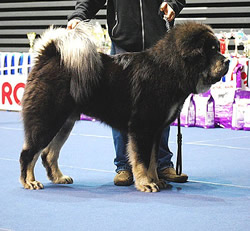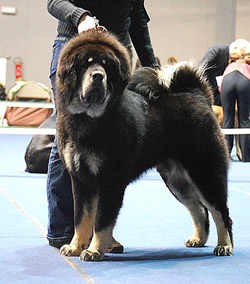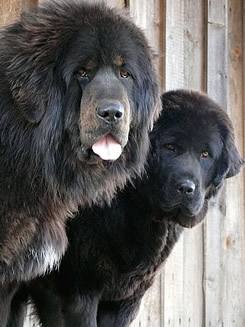Tibetan Mastiff
|
Photo with thanks to Ay Yangadoo,
www.ayyangadoo.pri.ee |
See more Tibetian Mastiff Pictures
Tibetan Mastiff
Breeders & Puppies For Sale If your
a Tibetan Mastiff breeder and have Tibetan Mastiff puppies for sale, send us your details for free and we will add to our Tibetan Mastiff Breeders page.
Tibetan Mastiff
Rescue Center Visit the Tibetan Mastiff rescue centers if your looking to rescue a Tibetan Mastiff, as well as learn more about the breed or just support the rescue centers for there hard work.
Group Working Dogs (KC)
Origin /
History The Tibetan Mastiff is a large, ancient breed believed to be the forerunner of all modern-day Mastiffs and Molossuses. The earliest record found of the Tibetan Mastiff dates back to 1211 B.C., making it one of the oldest breeds in the world. Marco Polo encountered the dogs in many of his travels, describing them in one account as “tall as a donkey with a voice as powerful as that of a lion.” Its size is such that one dog was enough to guard an entire city, the sacred Lhasa, against intruders.
Although the breed is native to Tibet, it was the British who refined the Tibetan Mastiff to its current standard. As Tibet reopened trade with the West, they began to export the dogs to England; one of them was given to Queen Victoria. As a result, today’s Tibetan Mastiffs are distinct from the ones that existed thousands of years ago. The breed is now rare in its native country, but is quickly gaining popularity in the West as a guardian and companion dog.
Appearance The Tibetan Mastiff comes in two sizes: the classic mastiff type and a slightly smaller mountain type. Both are sturdy in structure with an imposing form. They have a long double coat with the hair sometimes noticeably longer around the head, creating a lion-like appearance. The head is broad and the ears thick and hanging.
Colours The coat can come in black, blue-gray, or brown, occasionally with shades of gold. There may also be light to rich tan markings above and around the eyes, the sides of the muzzle, legs, throat, and the underside of the tail.
Temperament Temperament varies from dog to dog, but English-bred ones tend to be less aggressive than those bred in Tibet. Tibetan Mastiffs can be somewhat aloof, but are very loyal and protective of their families. They aren’t very demonstrative of their affection, but they love to please and greatly enjoy a sincere pat on the back. Their guarding instincts make them somewhat wary of strangers, so owners should socialize them early.
Height and
Weight The breed standard is around 25 to 28 inches at the withers, although some dogs grow well over 30 inches.
Common Health
Problems Tibetan Mastiffs are generally healthy, but they are not immune to common dog diseases. For instance, they are prone to hip dysplasia, a bone problem common to large dog breeds. There have also been cases or entropion and ectropion (eyelid problems), skin disease, hypothyroidism, overbite and underbite, missing teeth, heart disease, and retinal atrophy. Owners should ask for health certificates to make sure genetic flaws are not passed on.
Living Conditions Tibetan Mastiffs are not born to be housedogs; they like the outdoors, and besides, they are too big for most apartments. The ideal home is one with a large yard and fence at least six feet high. These dogs are known to bark at night due to their guarding instincts, so owners should let them sleep indoors unless they are trained to limit the barking.
Exercise
Requirements Tibetan Mastiffs need exercise like any other dog, but exercise should be kept light as their weight puts considerable strain on their joints. This is especially important for pups, whose bones are still soft. A short, leisurely walk every day should be enough.
Training Requirements The key to training a Tibetan Mastiff is to treat it as an equal. It’s important to respect the dog the way one does a young child: it has a mind of its own and doesn’t take well to being bossed around. Training should start early, when the dog’s innate stubbornness hasn’t yet kicked in, and should continue into early adulthood. Western-bred Mastiffs are more trainable than native Tibetans.
Life Expectancy Tibetan Mastiffs are long-lived compared to other large breeds. A healthy dog can live between 10 and 14 years.
Grooming Grooming needs vary by season. In winter, the coat grows very thick and should be brushed regularly to prevent tangling. They usually shed once a year; the coat should be brushed for half an hour each day to keep loose hairs from matting. Baths can be given as necessary.
Famous Examples
CompleteDogsGuide Comment
Breeders
Comments: Send us yours comments, advice for owners, potential owners etc.
Owners Comments: Send us any of your comments. Thanks in advance.
More Tibetan Mastiff Information: Check out our Tibetan Mastiff Clubs and links to more informative websites dedicated to the breed.
Submit your Tibetan Mastiff pictures Send us any pics of your Tibetan Mastiff, let us know there name and age and any other details. We'll add to this page. Contact us
| Tibetan Mastiff Photos |
 "Fahi"
"Fahi" |

"Fahi" |
|

"Abar" |
 "Abar" and "Eshana"
"Abar" and "Eshana" |
|